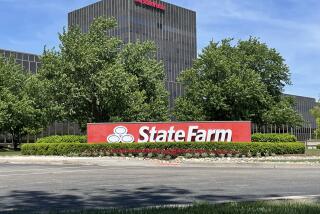Blue Shield of California seeks rate hikes of as much as 59% for individuals
- Share via
Another big California health insurer has stunned individual policyholders with huge rate increases — this time it’s Blue Shield of California seeking cumulative hikes of as much as 59% for tens of thousands of customers March 1.
Blue Shield’s action comes less than a year after Anthem Blue Cross tried and failed to raise rates as much as 39% for about 700,000 California customers.
San Francisco-based Blue Shield said the increases were the result of fast-rising healthcare costs and other expenses resulting from new healthcare laws.
“We raise rates only when absolutely necessary to pay the accelerating cost of medical care for our members,” the nonprofit insurer told customers last month.
In all, Blue Shield said, 193,000 policyholders would see increases averaging 30% to 35%, the result of three separate rate hikes since October.
Nearly 1 in 4 of the affected customers will see cumulative increases of more than 50% over five months.
While most policyholders received separate notices for the successive rate hikes, others were given the news all at once because they had contracts guaranteeing their rate for a year, Blue Shield spokesman Tom Epstein said.
Michael Fraser, a Blue Shield policyholder from San Diego, learned recently that his monthly bill would climb 59%, to $431 from $271.
“When I tell people, their jaws drop and their eyes bug out,” said Fraser, 53, a freelance advertising writer. “The amount is stunning.”
Like many people who hold individual policies, Fraser is self-employed. Others who carry such insurance include people who aren’t covered by employer plans or who have been laid off.
The Blue Shield increases triggered complaints to new Insurance Commissioner Dave Jones, and they could prove to be an early test of how the former Democratic state assemblyman deals with rate hikes and the insurance industry.
Anthem’s attempt to raise rates by up to 39% led to national outrage and helped President Obama marshal support for his healthcare overhaul. The insurer was ultimately forced to back down, accepting maximum rate hikes of 20%.
Jones said the Blue Shield move underscored the need for the Legislature to give the insurance commissioner legal authority to regulate insurance rates the same way he does automobile coverage.
At present, the commissioner can block increases only if insurers spend less than 70% of premium income on claims. Jones’ office said Blue Shield’s March 1 increase was under review.
“Blue Shield’s increases pose the same problem posed by Anthem Blue Cross last year and other health insurers as well,” Jones said in an interview. “My hope would be that Blue Shield would reexamine these rate hikes, particularly in the face of the impact they are having on individual policyholders.”
Blue Shield said the cost of health coverage was being driven up by large hospital expenses, doctors’ bills and prescription drug prices. Blue Shield’s Epstein said other factors also contributed to the three increases in five months.
On Oct. 1, he said, Blue Shield imposed increases averaging 18% and as high as 29%. Those hikes had been delayed for three months while state regulators examined Blue Shield’s filing, costing the company tens of millions of dollars.
Epstein said Blue Shield raised rates again Jan. 1 to pay for changes under the national healthcare overhaul and a new state law that bars insurers from charging women more than men. (Some policyholders will pay less under the state gender law, while others will pay more.)
A third round of hikes scheduled for March 1 comes in response to rising healthcare costs, Epstein said. Those increases will average 6.5% and be as high as 18%.
Some policyholders have seen their bills rise gradually over the last five months, while others will see the charges lumped together March 1.
“It’s unfortunate that they all came in a five-month period,” Epstein said. “Rates are going to continue to rise unless the cost of medical care is brought under control. We need to reduce what we pay to hospitals, medical groups and pharmaceutical companies.”
Despite the large increases, Epstein said Blue Shield would again lose “tens of millions of dollars” on its individual business in 2011.
Not included in the rate increases are 78,000 Blue Shield individual policyholders whose insurance is regulated by a second state agency, the Department of Managed Health Care. Those customers have seen two rate increases since October that together average 37%, Epstein said.
While Blue Shield’s cumulative rate increases are high, Anthem Blue Cross’ increases last year affected more people.
Anthem said Wednesday that it too expected to raise rates — an average of 9.8% for individual policyholders, effective April 1. That would come on top of increases in October averaging 14% that had been delayed for six months amid heightened scrutiny by state regulators.
Anthem is taking a cautious approach to its rate hikes given the controversy generated by last year’s plan for 39% hikes.
Spokeswoman Kristin Binns said the company priced its 2011 rates competitively, saying: “We understand that these are difficult economic times, and we are committed to working to moderate the impact of rate increases on our members.”
More to Read
Get the L.A. Times Politics newsletter
Deeply reported insights into legislation, politics and policy from Sacramento, Washington and beyond. In your inbox twice per week.
You may occasionally receive promotional content from the Los Angeles Times.










